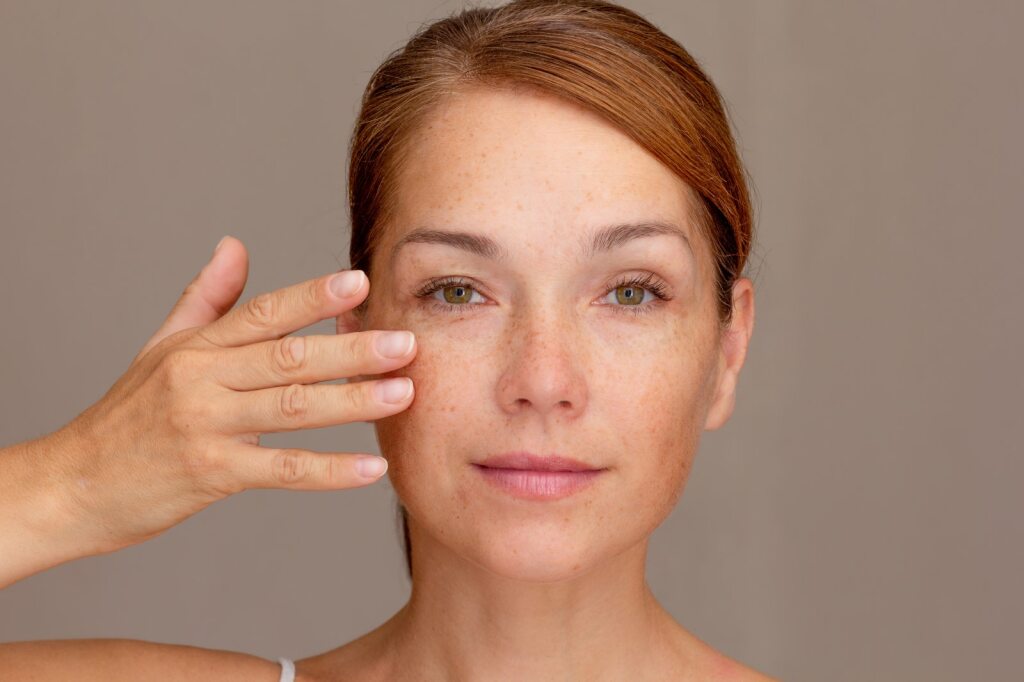Täyteaineet – Iän tuomien muutosten korjausta ilman kirurgiaa

Hyaluronihappo on ihon luonnollinen ainesosa, joka ylläpitää sen kosteutta ja kimmoisuutta. Iän myötä hyaluronihapon määrä vähenee, mikä tekee ihosta ohuemman, kuivemman ja altistaa sen juonteille sekä veltostumiselle.
Täyteainehoidoilla voidaan tehokkaasti korvata tätä luonnollista vähenemistä: iho saa lisää kosteutta ja menetettyä volyymia palautetaan täsmällisesti oikeisiin kohtiin. Lopputuloksena on nuorekkaampi, levänneempi ja raikkaampi ilme.
Huulten täyttö ja muotoilu
Huulten täyttö hyaluronihapolla ei tarkoita vain suurempia huulia, vaan ennen kaikkea harkittua ja yksilöllistä muotoilua, jolla korostetaan kasvojen alaosan tasapainoa ja raikastetaan yleisilmettä.
Hoidolla voidaan:
- Korostaa huulten luonnollista muotoa ja harmoniaa
- Korjata epäsymmetriaa ja selkeyttää huulirajoja
- Pehmentää ylähuulen pystysuuntaisia juonteita
- Parantaa huulten kosteustasapainoa ja sävyä sisältä käsin
Käytämme eri vahvuisia täyteaineita, jotka sisältävät puuduttavaa lidokaiinia, joka tekee hoidosta miellyttävämmän ja auttaa saavuttamaan ennakoitavan, luonnollisen lopputuloksen. Vaikutus kestää keskimäärin 9–12 kuukautta. Hoito sopii erinomaisesti sekä ensimmäiseen huulten muotoiluun että aiemmin tehdyn lopputuloksen ylläpitoon.
Poskipäiden kohotus ja volyymin palautus täyteaineilla
Ikääntyessä kasvojen keskiosan rasvakudos vähenee, mikä tekee ilmeestä väsyneen näköisen ja kasvonpiirteistä litteämmät. Poskipäiden täyttö täyteaineella voi tehokkaasti:
- Palauttaa menetettyä volyymia ja parantaa kasvojen rakennetta
- Kohottaa kudoksia ilman kirurgiaa ja luoda kevyen lifting-vaikutuksen
- Pehmentää nasolabiaali- ja marionettijuonteita
- Korostaa kasvojen luonnollisia, tasapainoisia mittasuhteita
Käytämme sekä tiiviitä hyaluronihappopohjaisia täyteaineita että polymaitohappoa (PLLA), joka stimuloi kehon omaa kollageenintuotantoa. Täyteaine valitaan yksilöllisesti toiveidesi ja kasvojesi anatomian mukaan. Tuloksen kesto voi olla jopa 2 vuotta.

Kyynelurien täyttö
Kyynelurien alue on usein ensimmäinen kohta, jossa ikääntymisen merkit näkyvät. Volyymin menetys ja ihon oheneminen silmien alla voivat saada ilmeen näyttämään väsyneeltä, vaikka olisit täysin virkeä ja levännyt. Täyteainehoidolla voidaan:
- Täyttää silmänalusten kuoppia ja tasoittaa painaumia
- Vähentää tummuutta ja varjostuksia
- Raikastaa katsetta ja palauttaa kasvoille levännyt ilme
Tällä herkällä alueella käytämme erityisen kevyitä ja pehmeitä täyteaineita, jotka injektoidaan ainoastaan tylpällä kanyylilla. Näin minimoidaan mustelmien ja turvotuksen riski sekä varmistetaan mahdollisimman luonnollinen lopputulos, joka kestää n. 8–12 kk.
Nasolabiaalijuonteiden täyttö täyteaineella
Nasolabiaalijuonteet eli hymyjuonteet ovat luonnollinen osa kasvojen anatomiaa, mutta iän myötä ne voivat syventyä kudosten veltostumisen ja painovoiman vaikutuksesta. Täyteainehoidoilla voidaan:
- Silottaa keskisyviä ja syviä juonteita
- Pehmentää hymyä vaikuttamatta ilmeen luonnollisuuteen
- Parantaa keskikasvojen rakennetta ja palauttaa volyymia
Hoidossa käytämme keskipaksuja täyteaineita, jotka asetetaan ihoon hellävaraisesti tylpällä kanyylilla. Tämä menetelmä minimoi mustelmien ja turvotuksen riskin ja takaa tasaisen lopputuloksen.
Nenän muotoilu täyteaineilla
Täyteaineilla tehtävä nenän muotoilu on ei-kirurginen vaihtoehto rinoplastialle. Kyseessä on toimenpide, jossa nenän muotoa korjataan hyaluronihappoinjektioiden avulla – ilman veistä tai pitkää toipumisaikaa. Hoidolla voidaan:
- Tasoittaa ja kaventaa nenänselkää
- Pehmentää kyömyä
- Nostaa nenän kärkeä
- Korjata epäsymmetriaa
- Hahmottaa, miltä mahdollinen kirurginen lopputulos voisi näyttää

Leuan muotoilu
Leuan muotoilu täyteaineilla on tehokas ja vähän kudoksia rasittava toimenpide, jossa käytetään paksumpia hyaluronihappopohjaisia aineita leuan linjan ja muodon parantamiseen.
Hoidosta voi olla hyötyä esimerkiksi, kun:
- Leuka on vetäytynyt tai näyttää litteältä
- Alakasvojen alueella esiintyy epäsymmetriaa
- Iän myötä on tapahtunut volyymin menetystä tai kudosten laskeutumista
- Kasvojen soikea muoto tai leukalinja kaipaa selkeytystä
- Kasvojen mittasuhteet ovat epätasapainossa edestä tai sivuprofiilista katsottuna
- Toivot muotoilua ilman kirurgiaa tai pitkää toipumisaikaa
Jo 1 ml täyteainetta voi riittää muuttamaan leukalinjan ilmettä selvästi ja tuomaan kasvoihin lisää ryhtiä ja itsevarmuutta. Erityisen harmonisia ja luonnollisia tuloksia saadaan, kun leuan muotoilu yhdistetään muiden alueiden, kuten nenän, poskipäiden tai leukakulmien muotoiluun tai botuliinihoitoon.
Miten leuan muotoilu täyteaineella etenee?
- Alkukonsultaatio: Lääkäri arvioi kasvojesi anatomian, kuuntelee toiveesi ja laatii yksilöllisen hoitosuunnitelman.
- Puudutus: Hoitokohtaan levitetään puuduttava voide tai tehdään paikallinen puudutusinjektio, jotta toimenpide olisi mahdollisimman miellyttävä.
- Täyteaineen injektointi: Valittu täyteaine ruiskutetaan tarkasti hoitoalueelle ohuella neulalla tai tylpällä kanyylilla. Injektoinnin tyyli ja paikka valitaan kasvojen rakenteen ja tavoitellun lopputuloksen mukaan.
- Jälkihoito-ohjeet: Saat yksityiskohtaiset ohjeet alueen hoidosta toimenpiteen jälkeen. Mustelmat ja lievä turvotus ovat mahdollisia, mutta yleensä ohimeneviä.
Toimenpiteen kesto: 15–40 minuuttia. Tulokset näkyvät heti hoidon jälkeen.
Kenelle leuan muotoilu täyteaineella ei sovi?
Toimenpidettä ei suositella, jos:
- Olet raskaana tai imetät
- Sinulla on tulehdus tai infektio hoitoalueella
- Sairastat syöpää
- Olet allerginen täyteaineen ainesosille
- Sinulla on taipumusta keloidiarpien muodostumiseen

Te kysyitte, me vastaamme
Ei ole. Botox ja täyteaine (filleri) ovat täysin eri aineita. Täyteaine tuo takaisin kadonnutta volyymia ja silottaa juonteita. Botox puolestaan rentouttaa lihaksia ja vähentää ilmejuonteita. Ne vaikuttavat eri tavalla, mutta yhdessä ne muodostavat tehokkaan yhdistelmän nuorekkaamman ja raikkaamman ilmeen saavuttamiseksi.
MESQ®
DoctusPlus Oy:n aputoiminimi
Yritys
DoctusPlus Oy
Y-tunnus
3154088-6
Käyntiosoite
Itämerenkatu 11-13 F, 00180 Helsinki
Puhelin
Sähköposti
Aukioloajat
Ma – Pe 11:00 – 19:00